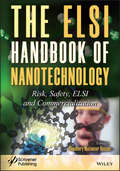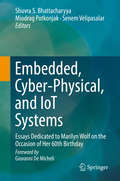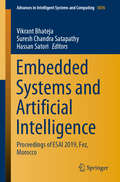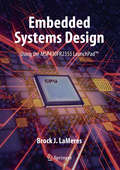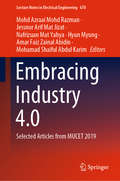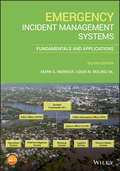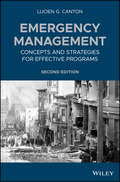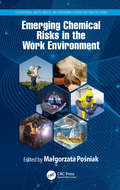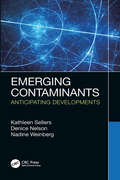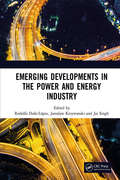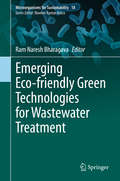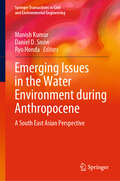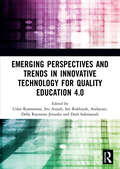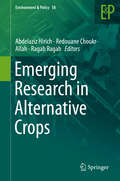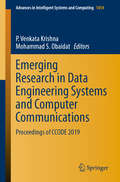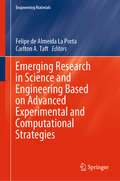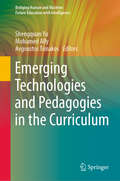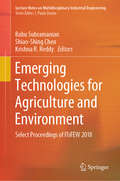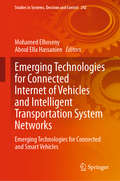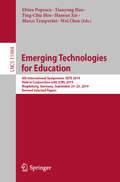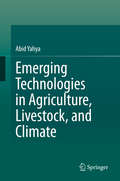- Table View
- List View
The ELSI Handbook of Nanotechnology: Risk, Safety, ELSI and Commercialization
by Chaudhery Mustansar HussainThis Handbook focuses on the recent advancements in Safety, Risk, Ethical Society and Legal Implications (ESLI) as well as its commercialization of nanotechnology, such as manufacturing. Nano is moving out of its relaxation phase of scientific route, and as new products go to market, organizations all over the world, as well as the general public, are discussing the environmental and health issues associated with nanotechnology. Nongovernmental science organizations have long since reacted; however, now the social sciences have begun to study the cultural portent of nanotechnology. Societal concerns and their newly constructed concepts, show nanoscience interconnected with the economy, ecology, health, and governance. This handbook addresses these new challenges and is divided into 7 sections: Nanomaterials and the Environment; Life Cycle Environmental Implications of Nanomanufacturing; Bioavailability and Toxicity of Manufactured Nanoparticles in Terrestrial Environments; Occupational Health Hazards of Nanoparticles; Ethical Issues in Nanotechnology; Commercialization of Nanotechnology; Legalization of Nanotechnology.
Embedded, Cyber-Physical, and IoT Systems: Essays Dedicated to Marilyn Wolf on the Occasion of Her 60th Birthday
by Shuvra S. Bhattacharyya Miodrag Potkonjak Senem VelipasalarThis Festschrift is in honor of Marilyn Wolf, on the occasion of her 60th birthday. Prof. Wolf is a renowned researcher and educator in Electrical and Computer Engineering, who has made pioneering contributions in all of the major areas in Embedded, Cyber-Physical, and Internet of Things (IoT) Systems. This book provides a timely collection of contributions that cover important topics related to Smart Cameras, Hardware/Software Co-Design, and Multimedia applications.Embedded systems are everywhere; cyber-physical systems enable monitoring and control of complex physical processes with computers; and IoT technology is of increasing relevance in major application areas, including factory automation, and smart cities. Smart cameras and multimedia technologies introduce novel opportunities and challenges in embedded, cyber-physical and IoT applications. Advanced hardware/software co-design methodologies provide valuable concepts and tools for addressing these challenges.The diverse topics of the chapters in this Festschrift help to reflect the great breadth and depth of Marilyn Wolf's contributions in research and education. The chapters have been written by some of Marilyn’s closest collaborators and colleagues.
Embedded Systems and Artificial Intelligence: Proceedings of ESAI 2019, Fez, Morocco (Advances in Intelligent Systems and Computing #1076)
by Suresh Chandra Satapathy Vikrant Bhateja Hassan SatoriThis book gathers selected research papers presented at the First International Conference on Embedded Systems and Artificial Intelligence (ESAI 2019), held at Sidi Mohamed Ben Abdellah University, Fez, Morocco, on 2–3 May 2019. Highlighting the latest innovations in Computer Science, Artificial Intelligence, Information Technologies, and Embedded Systems, the respective papers will encourage and inspire researchers, industry professionals, and policymakers to put these methods into practice.
Embedded Systems Design using the MSP430FR2355 LaunchPad™
by Brock J. LaMeresThis textbook for courses in Embedded Systems introduces students to necessary concepts, through a hands-on approach. LEARN BY EXAMPLE – This book is designed to teach the material the way it is learned, through example. Every concept is supported by numerous programming examples that provide the reader with a step-by-step explanation for how and why the computer is doing what it is doing. LEARN BY DOING – This book targets the Texas Instruments MSP430 microcontroller. This platform is a widely popular, low-cost embedded system that is used to illustrate each concept in the book. The book is designed for a reader that is at their computer with an MSP430FR2355 LaunchPadTM Development Kit plugged in so that each example can be coded and run as they learn. LEARN BOTH ASSEMBLY AND C – The book teaches the basic operation of an embedded computer using assembly language so that the computer operation can be explored at a low-level. Once more complicated systems are introduced (i.e., timers, analog-to-digital converters, and serial interfaces), the book moves into the C programming language. Moving to C allows the learner to abstract the operation of the lower-level hardware and focus on understanding how to “make things work”. BASED ON SOUND PEDAGOGY - This book is designed with learning outcomes and assessment at its core. Each section addresses a specific learning outcome that the student should be able to “do” after its completion. The concept checks and exercise problems provide a rich set of assessment tools to measure student performance on each outcome.
Embracing Industry 4.0: Selected Articles from MUCET 2019 (Lecture Notes in Electrical Engineering #678)
by Mohd Azraai Mohd Razman Jessnor Arif Mat Jizat Nafrizuan Mat Yahya Hyun Myung Amar Faiz Zainal Abidin Mohamad Shaiful Abdul KarimThis book highlights selected articles from the electrical engineering track, with a focus on the latest trends in electrical and electronic engineering toward embracing Industry 4.0, as part of the Malaysian Technical Universities Conference on Engineering and Technology—MUCET 2019. The event brings together researchers and professionals in the fields of engineering, research, and technology, and provides a platform for future collaborations and exchanges.
Emergency Incident Management Systems: Fundamentals and Applications
by Mark S. Warnick Louis N. Molino Sr.The second edition was to be written in order to keep both reader and student current in incident management. This was grounded in the fact that incident management systems are continually developing. These updates are needed to ensure the most recent and relevant information is provided to the reader. While the overall theme of the book will remain the same of the first edition, research and research-based case studies will be used to support the need for utilizing emergency incident management systems. Contemporary research in the use (and non-use) of an incident management system provides clear and convincing evidence of successes and failures in managing emergencies. This research provides areas where first responders have misunderstood the scope and use of an emergency incident management system and what the outcomes were. Contemporary and historical (research-based) case studies in the United States and around the globe have shown the consequences of not using emergency incident management systems, including some that led to increased suffering and death rates. Research-based case studies from major incidents will be used to show the detrimental effects of not using or misunderstanding these principles. One of the more interesting chapters in the new edition is what incident management is used around the world.
Emergency Incident Management Systems: Fundamentals and Applications
by Mark S. Warnick Louis N. Molino Sr.The second edition was to be written in order to keep both reader and student current in incident management. This was grounded in the fact that incident management systems are continually developing. These updates are needed to ensure the most recent and relevant information is provided to the reader. While the overall theme of the book will remain the same of the first edition, research and research-based case studies will be used to support the need for utilizing emergency incident management systems. Contemporary research in the use (and non-use) of an incident management system provides clear and convincing evidence of successes and failures in managing emergencies. This research provides areas where first responders have misunderstood the scope and use of an emergency incident management system and what the outcomes were. Contemporary and historical (research-based) case studies in the United States and around the globe have shown the consequences of not using emergency incident management systems, including some that led to increased suffering and death rates. Research-based case studies from major incidents will be used to show the detrimental effects of not using or misunderstanding these principles. One of the more interesting chapters in the new edition is what incident management is used around the world.
Emergency Management: Concepts and Strategies for Effective Programs
by Lucien G. CantonProvides a comprehensive examination of emergency management and offers concepts and strategies for creating effective programs This book looks at the larger context within which emergency management response occurs, and stresses the development of a program to address a wide range of issues. Not limited to traditional emergency response to natural disasters, it addresses a conceptual model capable of integrating multiple disciplines and dealing with unexpected emergencies. Emergency Management: Concepts and Strategies for Effective Programs, Second Edition starts by focusing on the three pillars on which successful emergency management is based: an understanding of history, knowledge of social science research, and technical expertise in emergency management operations. It provides insight as to how emergency management has evolved and suggests reasons why the current method of response planning doesn’t work as well as it should. The book then goes on to discuss establishing and administering the emergency management program. It looks at the analysis of risk as the basis for strategy development, and considers both the traditional macro view of hazard identification and analysis as well as the micro view required for continuity planning. Strategy development is examined next, followed by coverage of planning process, techniques and methods. The book finishes with chapters on coordinating response, leading in crisis, and crisis management. Features two new chapters on the development of national response strategy and leadership in a crisis Incorporates the Principles of Emergency Management adopted by many emergency management professional associations and agencies Encourages the development of an enterprise wide program to address a wide range of potential threats Covers the various phases of comprehensive emergency management Integrates academic research with practical experience and case studies Emergency Management: Concepts and Strategies for Effective Programs is an important book that will benefit students, law enforcement, and state and local emergency managers and planners involved in emergency management.
Emergency Management: Concepts and Strategies for Effective Programs
by Lucien G. CantonProvides a comprehensive examination of emergency management and offers concepts and strategies for creating effective programs This book looks at the larger context within which emergency management response occurs, and stresses the development of a program to address a wide range of issues. Not limited to traditional emergency response to natural disasters, it addresses a conceptual model capable of integrating multiple disciplines and dealing with unexpected emergencies. Emergency Management: Concepts and Strategies for Effective Programs, Second Edition starts by focusing on the three pillars on which successful emergency management is based: an understanding of history, knowledge of social science research, and technical expertise in emergency management operations. It provides insight as to how emergency management has evolved and suggests reasons why the current method of response planning doesn’t work as well as it should. The book then goes on to discuss establishing and administering the emergency management program. It looks at the analysis of risk as the basis for strategy development, and considers both the traditional macro view of hazard identification and analysis as well as the micro view required for continuity planning. Strategy development is examined next, followed by coverage of planning process, techniques and methods. The book finishes with chapters on coordinating response, leading in crisis, and crisis management. Features two new chapters on the development of national response strategy and leadership in a crisis Incorporates the Principles of Emergency Management adopted by many emergency management professional associations and agencies Encourages the development of an enterprise wide program to address a wide range of potential threats Covers the various phases of comprehensive emergency management Integrates academic research with practical experience and case studies Emergency Management: Concepts and Strategies for Effective Programs is an important book that will benefit students, law enforcement, and state and local emergency managers and planners involved in emergency management.
Emerging Chemical Risks in the Work Environment (Occupational Safety, Health, and Ergonomics)
by Małgorzata PośniakAround the world, the production and use of nanomaterials, as well as carcinogenic, mutagenic, reprotoxic substances (CMR) and endocrine disruptors has systematically increased. The increase in production has exposed workers to hazardous substances in practically all branches of the world economy. Readers will have access to up-to-date and comprehensive knowledge on emerging risks related to nanomaterials, endocrine disruptors, reprotoxic, carcinogenic and mutagenic substances, which are related to the development of technologies and workplaces. The book will provide the tools for occupational risk assessment of chemical substances for which there are no safety levels of exposure as well as an indication of methods and measurements to protect human health and reduce chemical risks at the workplace. This book creates awareness for employers, employees and safety experts about emerging risks related to chemical agents resulting in the reduction of cancer, reproductive system diseases, cases of abnormal child development, hormonal system disorders leading to abnormal metabolism, obesity, and diabetes. Features: Comprehensive information on emerging and newly identified chemical hazards Delivers the latest data on methods and tools for identification, assessing and reducing health risks Provides practical occupational safety advice and recommendations Real life examples from measurements carried out in the workplaces "The monograph, due to the high universality of its considerations, can be addressed to a very wide audience. It is an important compendium of knowledge, which can be used by health and safety services, employers, people designing new technologies and those interested in this issue. It is a valuable and up-to-date study, among others because it uses the latest literature and quotes current legal acts.” —Sławomir Czerczak, Nofer Institute of Occupational Medicine, Poland
Emerging Chemical Risks in the Work Environment (Occupational Safety, Health, and Ergonomics)
by Malgorzata Po 347 NiakAround the world, the production and use of nanomaterials, as well as carcinogenic, mutagenic, reprotoxic substances (CMR) and endocrine disruptors has systematically increased. The increase in production has exposed workers to hazardous substances in practically all branches of the world economy. Readers will have access to up-to-date and comprehensive knowledge on emerging risks related to nanomaterials, endocrine disruptors, reprotoxic, carcinogenic and mutagenic substances, which are related to the development of technologies and workplaces. The book will provide the tools for occupational risk assessment of chemical substances for which there are no safety levels of exposure as well as an indication of methods and measurements to protect human health and reduce chemical risks at the workplace. This book creates awareness for employers, employees and safety experts about emerging risks related to chemical agents resulting in the reduction of cancer, reproductive system diseases, cases of abnormal child development, hormonal system disorders leading to abnormal metabolism, obesity, and diabetes. Features: Comprehensive information on emerging and newly identified chemical hazards Delivers the latest data on methods and tools for identification, assessing and reducing health risks Provides practical occupational safety advice and recommendations Real life examples from measurements carried out in the workplaces "The monograph, due to the high universality of its considerations, can be addressed to a very wide audience. It is an important compendium of knowledge, which can be used by health and safety services, employers, people designing new technologies and those interested in this issue. It is a valuable and up-to-date study, among others because it uses the latest literature and quotes current legal acts.” —Sławomir Czerczak, Nofer Institute of Occupational Medicine, Poland
Emerging Contaminants: Anticipating Developments
by Kathleen Sellers Denice K. Nelson Nadine WeinbergEmerging Contaminants: Anticipating Developments examines the factors that have led "new" environmental contaminants to emerge in the past and combines the lessons learned to anticipate potential new developments. The analyses described in this book originate in multiple disciplines: the science of toxicology; environmental law and regulation; the field of product stewardship; and the social science which explains why ideas take hold. Over a dozen case studies of contaminants that emerged as environmental issues over the last hundred years illustrate crucial points. The results of the analyses in this book support a step-by-step method to assess the potential for a contaminant to emerge, and a framework to apply those conclusions to managing site liabilities. Features: Describes an unprecedented understanding of why contaminants emerge as issues, based on a multidisciplinary analysis Makes abstract concepts tangible, basing analyses on data and illustrating key points with case studies Enables readers to anticipate and prepare to manage future challenges associated with emerging chemicals Presents an analytical framework for companies to assess and manage business risks Written for regulators, policymakers, industry professionals with responsibility for contaminated site management, as well as attorneys, and consultants, this book provides a framework for anticipating the emergence of new contaminants so that the risks–whether to human health and the environment or to a business–can be anticipated and appropriately managed.
Emerging Contaminants: Anticipating Developments
by Kathleen Sellers Denice K. Nelson Nadine WeinbergEmerging Contaminants: Anticipating Developments examines the factors that have led "new" environmental contaminants to emerge in the past and combines the lessons learned to anticipate potential new developments. The analyses described in this book originate in multiple disciplines: the science of toxicology; environmental law and regulation; the field of product stewardship; and the social science which explains why ideas take hold. Over a dozen case studies of contaminants that emerged as environmental issues over the last hundred years illustrate crucial points. The results of the analyses in this book support a step-by-step method to assess the potential for a contaminant to emerge, and a framework to apply those conclusions to managing site liabilities. Features: Describes an unprecedented understanding of why contaminants emerge as issues, based on a multidisciplinary analysis Makes abstract concepts tangible, basing analyses on data and illustrating key points with case studies Enables readers to anticipate and prepare to manage future challenges associated with emerging chemicals Presents an analytical framework for companies to assess and manage business risks Written for regulators, policymakers, industry professionals with responsibility for contaminated site management, as well as attorneys, and consultants, this book provides a framework for anticipating the emergence of new contaminants so that the risks–whether to human health and the environment or to a business–can be anticipated and appropriately managed.
Emerging Developments in the Power and Energy Industry: Proceedings of the 11th Asia-Pacific Power and Energy Engineering Conference (APPEEC 2019), April 19-21, 2019, Xiamen, China
by Rodolfo Dufo-López Jaroslaw Krzywanski Jai SinghPower and Energy Engineering are important and pressing topics globally, covering issues such as shifting paradigms of energy generation and consumption, intelligent grids, green energy and environmental protection. The 11th Asia-Pacific Power and Energy Engineering Conference (APPEEC 2019) was held in Xiamen, China from April 19 to 21, 2019. APPEEC has been an annual conference since 2009 and has been successfully held in Wuhan (2009 & 2011), Chengdu (2010 & 2017), Shanghai (2012 & 2014), Beijing (2013 & 2015), Suzhou (2016) and Guilin (2018), China. The objective of APPEEC 2019 was to provide scientific and professional interactions for the advancement of the fields of power and energy engineering. APPEEC 2019 facilitated the exchange of insights and innovations between industry and academia. A group of excellent speakers have delivered keynote speeches on emerging technologies in the field of power and energy engineering. Attendees were given the opportunity to give oral and poster presentations and to interface with invited experts.
Emerging Eco-friendly Green Technologies for Wastewater Treatment (Microorganisms for Sustainability #18)
by Ram Naresh BharagavaAs we know, rapid industrialization is a serious concern in the context of a healthy environment and public health due to the generation of huge volumes of toxic wastewater. Although various physico-chemical and biological approaches are available for the treatment of this wastewater, many of them are not effective. Now, there a number of emerging ecofriendly, cost-effective approaches utilizing microorganisms (bacterial/fungi/algae), green plants or their enzymes, and constructed wetland treatment systems in the treatment of wastewaters containing pollutants such as endocrine disrupting chemicals, toxic metals, pesticides, dyes, petroleum hydrocarbons and phenolic compounds. This book provides a much-needed, comprehensive overview of the various types of wastewater and their ecotoxicological effects on the environment, humans, animals and plants as well as various emerging and eco-friendly approaches for their treatment. It provides insights into the ecological problems and challenges in the treatment and management of wastewaters generated by various sources.
Emerging Issues in the Water Environment during Anthropocene: A South East Asian Perspective (Springer Transactions in Civil and Environmental Engineering)
by Manish Kumar Daniel D. Snow Ryo HondaThis book intends to bring together and integrate the subject matter of water quality. The book covers aspects of water related to climate change, emerging aspects of engineering sciences, bio-geochemical sciences, hydro geochemistry, river management and morphology, social sciences, and public policy. The book covers the role of disruptive innovations in water management, policy formation and impact mitigation strategies. The book includes lab results as well as case studies. It provides recommendations and solutions for policy making and sustainable water management. The chapters in this book deal cohesively with many aspects of the water environment during the Anthropocene era. The contents cover myriad issues, such as land degradation, water scarcity, urbanization, climate change, and disruptive innovation. The book also discusses issues highly pertinent to society and sustainability, such as the prevalence of enteric viruses and pharmaceutical residues as a possible anthropogenic markers in the aquatic environment. The book will prove useful for students, professionals, and researchers working on various aspects of water related concerns.
Emerging Perspectives and Trends in Innovative Technology for Quality Education 4.0: Proceedings of the 1st International Conference on Innovation in Education and Pedagogy (ICIEP 2019), October 5, 2019, Jakarta, Indonesia
by Isti Rokhiyah Andayani Della Raymena Jovanka Dodi Sukmayadi Udan Kusmawan Siti AisyahIndustrial Revolution 4.0 has dramatically changed the business and social landscape, including human behavior not only in advanced countries but also in emerging countries. Technology development affects many aspects in our society, including education. Distance learning, big data and analytics, artificial intelligent and many digital innovations have been released to improve better quality education in our society. These proceedings provide selected papers/research about innovative digital technology in education and pedagogy in Industrial revolution 4.0 covering issues like: pedagogy, education management, early childhood education, research in education, training and vocational education and social science education, earth science education and art/linguistic education related to digital innovation. This book provides details beyond what is possible to be included in an oral presentation and constitute a concise but timely medium for the dissemination of recent research results. It will be invaluable to professionals and academics in the field of education and pedagogy to get an understanding of recent research.
Emerging Research in Alternative Crops (Environment & Policy #58)
by Abdelaziz Hirich Redouane Choukr-Allah Ragab RagabThis book provides case studies on cultivating alternative crops and presents new cropping systems in many regions of the world. It focusses on new emerging research topics aiming to study all aspects of adaptation under several stresses including agricultural, environmental, biological and socioeconomic issues. The book also provides operational and practical solutions for scientists, producers, technology developers and managers to succeed the cultivation of new alternative crops and, consequently, to achieve food security.Many regions in the world are suffering from water scarcity, soil and water salinization and climate change. These conditions make it difficult to achieve food security by cultivating conventional crops. A renaissance of interest for producing alternative crops under water scarcity and water salinization has been, therefore, implemented primarily among small-scale producers, researchers and academics.The use of alternative crops (quinoa, amaranth, legume crops, halophytes, …etc.) may provide some environmental benefits such as valorization of salt-affected soils, reduced pesticide application, enhanced soil and water quality and promotion of wildlife diversity. This also may provide some economic benefits such as providing the opportunity for producers to take advantage of new markets and premium prices, spreading the economic risk and strengthening local economies and communities. Furthermore, alternative crops are often rich in proteins and minerals, and even some of them are Gluten free (quinoa). This reflects their importance to achieve food security in quantity and quality scale. The year 2013 was exceptional for alternative crops as it was the international year of quinoa celebrated by Food and Agriculture Organization (FAO). This reflects the importance of research conducted on quinoa and other alternative crops in many regions of the world.
Emerging Research in Data Engineering Systems and Computer Communications: Proceedings of CCODE 2019 (Advances in Intelligent Systems and Computing #1054)
by Mohammad S. Obaidat P. Venkata KrishnaThis book gathers selected papers presented at the 2nd International Conference on Computing, Communications and Data Engineering, held at Sri Padmavati Mahila Visvavidyalayam, Tirupati, India from 1 to 2 Feb 2019. Chiefly discussing major issues and challenges in data engineering systems and computer communications, the topics covered include wireless systems and IoT, machine learning, optimization, control, statistics, and social computing.
Emerging Research in Science and Engineering Based on Advanced Experimental and Computational Strategies (Engineering Materials)
by Felipe de Almeida La Porta Carlton A. TaftIn this book, the authors discuss some of the main challenges and new opportunities in science and engineering research, which involve combining computational and experimental approaches as a promising strategy for arriving at new insights into composition–structure–property relations, even at the nanoscale. From a practical standpoint, the authors show that significant improvements in the material/biomolecular foresight by design, including a fundamental understanding of their physical and chemical properties, are vital and will undoubtedly help us to reach a new technological level in the future.
Emerging Technologies and Pedagogies in the Curriculum (Bridging Human and Machine: Future Education with Intelligence)
by Shengquan Yu Mohamed Ally Avgoustos TsinakosThis book explores the technologies that can be used in curricula to make education “smarter” and more adaptive in order to better meet the needs of today’s learners. The main emphasis is based on the theory and best practices of incorporating emerging technologies into curricula so as to educate learners in the 21st century. The book provides valuable insights into the future of education and examines which pedagogies are most suitable for integrating emerging technologies. It will help educators and stakeholders design and implement curricula that effectively prepare learners for the challenges of tomorrow.
Emerging Technologies for Agriculture and Environment: Select Proceedings of ITsFEW 2018 (Lecture Notes on Multidisciplinary Industrial Engineering)
by Babu Subramanian Shiao-Shing Chen Krishna R. ReddyThis book comprises select proceedings of the International Conference on Emerging Technologies for Farming – Energy & Environment – Water (ITsFEW 2018). The contents are divided into three parts viz., (i) Developments in Farming, (ii) Energy and Environment, and (iii) Water Conservation and Management. The book aims to provide timely solutions, using innovative and emerging technologies, to the global challenges in agriculture, energy, environment, and water management. Some of the topics covered in this book include remote sensing for smart farming, GIS, irrigation engineering, soil science and agronomy, smart grids, renewable energy, energy management systems, energy storage technologies, biological water treatment, industrial waste water treatment, watershed management and sustainability. Given the wide range of topics discussed, the book will be very useful for students, researchers and practitioners interested in agricultural and environmental engineering.
Emerging Technologies for Connected Internet of Vehicles and Intelligent Transportation System Networks: Emerging Technologies for Connected and Smart Vehicles (Studies in Systems, Decision and Control #242)
by Mohamed Elhoseny Aboul Ella HassanienThis book discusses vehicular communication systems, IoT, intelligent transportation systems and the Internet of Vehicles, and also introduces destination marketing in a structured manner. It is primarily intended for research students interested in emerging technologies for connected Internet of Vehicles and intelligent transportation system networks; academics in higher education institutions, including universities and vocational colleges; IT professionals; policy makers; and legislators. The book can also be used as a reference resource for both undergraduate and graduate studies. Written in plain and simple language, it describes new concepts so that they are accessible to readers without prior knowledge of the field.
Emerging Technologies for Education: 4th International Symposium, SETE 2019, Held in Conjunction with ICWL 2019, Magdeburg, Germany, September 23–25, 2019, Revised Selected Papers (Lecture Notes in Computer Science #11984)
by Elvira Popescu Tianyong Hao Ting-Chia Hsu Haoran Xie Marco Temperini Wei ChenThis book constitutes the thoroughly refereed post-workshop proceedings of the 4th International Symposium, SETE 2019, held in conjunction with ICWL 2019, in Magdeburg, Germany, in September 2019. The 10 full and 6 short papers presented together with 24 papers from 5 workshops were carefully reviewed and selected from 34 submissions. The papers cover the latest findings in various areas, such as: virtual reality and game-based learning; learning analytics; K-12 education; language learning; design, model and implementation of e-learning platforms and tools; digitalization and industry 4.0; pedagogical issues, practice and experience sharing.
Emerging Technologies in Agriculture, Livestock, and Climate
by Abid YahyaThis book provides applications of wireless sensor networks (WSN) in environmental monitoring, with an emphasis on livestock disease detection and agricultural management in Africa to aid farmers. This proposed system entails current and innovative monitoring technologies intended to improve agricultural conditions in Africa, with a focus on Botswana, and addresses the Internet of Things (IoT) as a set of remote monitoring protocols using WSNs to improve and ensure proper environmental maintenance. In this book, the author introduces WSNs, and how the IoT can be applied to develop a system of "smart agriculture" in Africa, taking into account livestock health, climate change impacts on crops and wildlife, and technological innovations in response to climate change such as windmills and solar panels. The book will be interesting to students and researchers in engineering and life sciences, as well as practitioners working with sensing technologies for agricultural monitoring and improvement.
